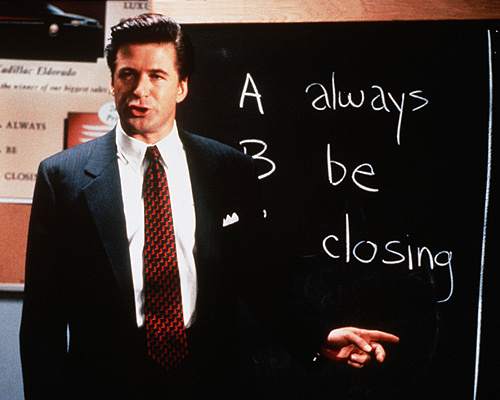"Put that coffee down!" the Alec Baldwin character in Glengarry Glen Ross shouted as he browbeat a salesman who hadn't been making his numbers. "Coffee's for closers only."
From Death of a Salesman to Boiler Room to The Wolf of Wall Street, Hollywood has never been especially kind to salespeople, usually depicting them as desperate, dishonest or both.
The reality, of course, is that sales professionals are like everyone else -- they just have one of the toughest jobs in the world.
The roughly 15 million non-retail salespeople in the United States (11 percent of the total full-time workforce, according to the Bureau of Labor Statistics) are directly responsible for driving revenue growth for their companies. They're under intense pressure to "Always Be Closing." And they operate in a constantly changing business environment fraught with uncertainty.
Sales teams can use all the help they can get. But in an era of stunning technological advance, when a single iPhone has more than three times the processing power of a 1980s supercomputer, when we're seeing the advent of the driverless car and shipping drones, the processes that support how a sales team advances deals to make their quarterly number haven't materially changed in a generation.
At a time when companies are using insights from data to transform so many other parts of the business, from customer success to risk management, sales organizations continue to rely on traditional, manual processes that are anchored in anecdotal information and are very hard to scale.
- Sales calendars are filled with tedious weekly forecast calls and one-on-one meetings, where salespeople are drilled with questions from senior leaders on the dynamics of every deal to justify their projected numbers.
No wonder so many companies end up facing the dreaded end-of-quarter surprises that threaten to frustrate employees, investors and shareholders.
It doesn't have to be this way. Companies already have the answer to the problem in the data science, machine learning and artificial intelligence technologies they're likely using in other parts of the business.
Data science already has seen broad adoption across industries, from how retailers predict customer behavior to forecasting of election results to evaluation of baseball players. It can find patterns and predictive signals in enormous volumes of data that humans cannot see.
The time is overdue to extend the model to sales.
As processing power keeps growing and algorithms improve, it's now possible to use analytics to extract actionable insights in a dynamic, complicated, high-stakes environment like sales. What are the gaps toward meeting target or number? What are the key deals that should be prioritized to close the gap?
Computers can analyze data and answer these questions better and faster than a person ever could. They can create what-if scenarios to model risk and reward tradeoffs of swing deals, or discover high-risk and high-value deals, or allocate sales resources to the deals with the highest likelihood of closing.
While sales is and will always be a human endeavor and as much art as science -- intuition and acumen obviously play an important role -- the introduction of predictive analytics into the sales process is a game-changer on par with Wall Street's embrace in recent years of quants, the math geniuses now considered indispensable to investment banks and hedge funds in forecasting market behavior.
A more apt image for salespeople should no longer come from the Hollywood classics but from "Iron Man." Just as Tony Stark depends on technology to get his job done, the modern sales leader cannot drive superior results without the power of machines.
K. V. Rao is founder and CEO of Aviso, producers of sales analytics software that helps sales teams optimize their performance and exceed revenue goals.
